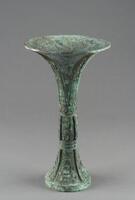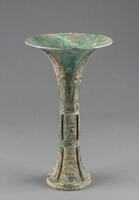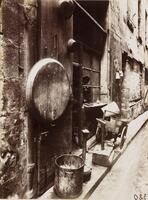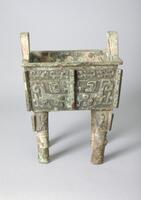15 UMMA Objects
15 UMMA Objects
![A glazed and speckled porcelain offering dish for an altar. The base is a wide decorated cylinder which tapers sharply into a narrow top. The base supports a wide, shallow bowl.<br />
<br />
This ritual dish was produced at a regional kiln. It is a low-quality object with a rough texture, made from the clay mixed with sand, contaminated with many impurities on the tray. Its glaze is dark with blue-green tints, giving the vessel the appearance of celadon. Its foot has an octagonal cross-section.<br />
[Korean Collection, University of Michigan Museum of Art (2014) p.200] A glazed and speckled porcelain offering dish for an altar. The base is a wide decorated cylinder which tapers sharply into a narrow top. The base supports a wide, shallow bowl.<br />
<br />
This ritual dish was produced at a regional kiln. It is a low-quality object with a rough texture, made from the clay mixed with sand, contaminated with many impurities on the tray. Its glaze is dark with blue-green tints, giving the vessel the appearance of celadon. Its foot has an octagonal cross-section.<br />
[Korean Collection, University of Michigan Museum of Art (2014) p.200]](/media/W1siZiIsIjIwMjIvMDkvMjQvNm45anZucHNldV9kZWZhdWx0LmpwZyJdLFsicCIsInRodW1iIiwiMjQweDIwMCJdXQ?sha=ccdbeadfd710d294)
Korean (Korean (culture or style))
Altar Dish
1850 – 1899
Gift of Ok Ja Chang and the Chang Family
2009/2.47

Chinese (Chinese (culture or style))
Gu (libation goblet, one of a pair with 1948/1.118)
8700 BCE
Bequest of Margaret Watson Parker
1948/1.117

Chinese (Chinese (culture or style))
Gu (libation goblet, one of a pair with 1948/1.117)
8700 BCE
Bequest of Margaret Watson Parker
1948/1.118

Eugène Atget (French (culture or style))
Un Coin de la Rue Reynie
1912
Museum Purchase made possible by the Friends of the Museum of Art
1971/2.140
![This is a ritual bowl with a high foot. A same type of this bowl is found in the storeroom of Changdeokgung Palace. It was coated with the transparent glaze with pale blue tints. The glazed surface is impeccable. The qualities of the clay and glaze suggest that this bowl was produced at the kiln in Bunwon-ri, Gwangju-si, Gyeonggi-do in the late 19th century, the last official court kiln of the Joseon Dynasty.<br />
[Korean Collection, University of Michigan Museum of Art (2014) p.194] This is a ritual bowl with a high foot. A same type of this bowl is found in the storeroom of Changdeokgung Palace. It was coated with the transparent glaze with pale blue tints. The glazed surface is impeccable. The qualities of the clay and glaze suggest that this bowl was produced at the kiln in Bunwon-ri, Gwangju-si, Gyeonggi-do in the late 19th century, the last official court kiln of the Joseon Dynasty.<br />
[Korean Collection, University of Michigan Museum of Art (2014) p.194]](/media/W1siZiIsIjIwMjIvMDkvMjQvNHJ4b2psa245NV9kZWZhdWx0LmpwZyJdLFsicCIsInRodW1iIiwiMjQweDIwMCJdXQ?sha=16fe884f5e2c6610)
Korean (Korean (culture or style))
Deep bowl on high foot
19th century
Gift of Bruce and Inta Hasenkamp and Museum purchase made possible by Elder and Mrs. Sang-Yong Nam
2004/1.300
![A short glazed and speckled gray porcelain offering dish for an altar. The base is a wide, slightly tapered cylinder which at the top is attached to a shallow dish. At the bottom of the base as well as a circle on the top of the dish there is some discoloration and morphing of the ceramic.<br />
<br />
This dish is gray in color and has large amounts of ash and pinholes on the surface. It is a low-grade object, with sand spur makrs remaining on the inner base due to fired among a stack of other vessels. Coarse sand is stuck to the foot.<br />
[Korean Collection, University of Michigan Museum of Art (2014) p.198] A short glazed and speckled gray porcelain offering dish for an altar. The base is a wide, slightly tapered cylinder which at the top is attached to a shallow dish. At the bottom of the base as well as a circle on the top of the dish there is some discoloration and morphing of the ceramic.<br />
<br />
This dish is gray in color and has large amounts of ash and pinholes on the surface. It is a low-grade object, with sand spur makrs remaining on the inner base due to fired among a stack of other vessels. Coarse sand is stuck to the foot.<br />
[Korean Collection, University of Michigan Museum of Art (2014) p.198]](/media/W1siZiIsIjIwMjIvMDkvMjQvOHBxenY1eHJicF9kZWZhdWx0LmpwZyJdLFsicCIsInRodW1iIiwiMjQweDIwMCJdXQ?sha=d276c757b88de922)
Korean (Korean (culture or style))
Altar Dish
1850 – 1899
Gift of Ok Ja Chang and the Chang Family
2009/2.44
![A glazed porcelain offering dish for an altar. The base is a wide cylinder which tapers sharply into a narrow top. The base supports a wide, almost flat disk as the bowl.<br />
<br />
The dish is made from iron-rich clay that tinged the bowl with green-brown. The foot retains traces of sand spurs in eight places. Glaze on the reverse side of the vessel has crawled in parts, revealing the clay body and producing many flaws. This vessel was produced at a regional kiln.<br />
[Korean Collection, University of Michigan Museum of Art (2014) p.200] A glazed porcelain offering dish for an altar. The base is a wide cylinder which tapers sharply into a narrow top. The base supports a wide, almost flat disk as the bowl.<br />
<br />
The dish is made from iron-rich clay that tinged the bowl with green-brown. The foot retains traces of sand spurs in eight places. Glaze on the reverse side of the vessel has crawled in parts, revealing the clay body and producing many flaws. This vessel was produced at a regional kiln.<br />
[Korean Collection, University of Michigan Museum of Art (2014) p.200]](/media/W1siZiIsIjIwMjIvMDkvMjQvOW9jeDBhbTlsaV9kZWZhdWx0LmpwZyJdLFsicCIsInRodW1iIiwiMjQweDIwMCJdXQ?sha=6d1deaa4f9e006d8)
Korean (Korean (culture or style))
Altar Dish
1850 – 1899
Gift of Ok Ja Chang and the Chang Family
2009/2.48

Chinese (Chinese (culture or style))
Fang ding (“square tripod” cooking vessel) with taotie mask and gui dragon design
8800 BCE
Museum purchase for the James Marshall Plumer Memorial Collection
1961/2.82

Chinese (Chinese (culture or style))
Yao Ritual Scroll
1800 – 1966
Gift of Mr. and Mrs. Karl Bass of Kabaco Tools, Inc.
1983/2.122
![A tall glazed and speckled white-blue porcelain offering dish for an altar. The base is a wide, slightly tapered cylinder. Where the base of the dish and the top of the base meet there is a bowl-shape ring as the bottom of the dish and a wide angled lip that surrounds it.<br />
<br />
A type of white porcelain ritual vessel, this cup stand was produced at a kiln in Bunwon-ri, Gwanju-si, Gyeonggido, the last official court kiln of the Joseon Dynasty. Its foot is high and has coarse sand spur marks on the foot rim. It is robust, flawless and coated with a transparent glaze with pale blue tints.<br />
[Korean Collection, University of Michigan Museum of Art (2014) p.201] A tall glazed and speckled white-blue porcelain offering dish for an altar. The base is a wide, slightly tapered cylinder. Where the base of the dish and the top of the base meet there is a bowl-shape ring as the bottom of the dish and a wide angled lip that surrounds it.<br />
<br />
A type of white porcelain ritual vessel, this cup stand was produced at a kiln in Bunwon-ri, Gwanju-si, Gyeonggido, the last official court kiln of the Joseon Dynasty. Its foot is high and has coarse sand spur marks on the foot rim. It is robust, flawless and coated with a transparent glaze with pale blue tints.<br />
[Korean Collection, University of Michigan Museum of Art (2014) p.201]](/media/W1siZiIsIjIwMjIvMDkvMjQvMmE4MjZsdGVic19kZWZhdWx0LmpwZyJdLFsicCIsInRodW1iIiwiMjQweDIwMCJdXQ?sha=bee5ad8eeebfc1db)
Korean (Korean (culture or style))
Altar Dish
1850 – 1899
Gift of Ok Ja Chang and the Chang Family
2009/2.41
![A tall stoneware bowl with a short, tapered cylindrical base. The bowl itself curves into a flat bottom where it meets the foot-base.<br />
<br />
The high iron content in the clay and glaze of this bowl produces a green-brown colour. In the Honam region (southwestern region including Jeollabuk-do and Jeollanam-do), the potters produced many vessels with celadon clay in the typical shapes of the white porcelain, thus resulting in the colors that resembles that of green celadon. This bowl is green-brown in color but has transparent glaze, giving it a very shiny surface. The entire foot was glazed, while there are eight sand spur marks on the foot rim. It was slightly deformed in the kiln, with the result the rim is not completely horizontal.<br />
[Korean Collection, University of Michigan Museum of Art (2014) p.195] A tall stoneware bowl with a short, tapered cylindrical base. The bowl itself curves into a flat bottom where it meets the foot-base.<br />
<br />
The high iron content in the clay and glaze of this bowl produces a green-brown colour. In the Honam region (southwestern region including Jeollabuk-do and Jeollanam-do), the potters produced many vessels with celadon clay in the typical shapes of the white porcelain, thus resulting in the colors that resembles that of green celadon. This bowl is green-brown in color but has transparent glaze, giving it a very shiny surface. The entire foot was glazed, while there are eight sand spur marks on the foot rim. It was slightly deformed in the kiln, with the result the rim is not completely horizontal.<br />
[Korean Collection, University of Michigan Museum of Art (2014) p.195]](/media/W1siZiIsIjIwMjIvMDkvMjQvNnplcm1iZmV4al9kZWZhdWx0LmpwZyJdLFsicCIsInRodW1iIiwiMjQweDIwMCJdXQ?sha=b9f5008829c06e1d)
Korean (Korean (culture or style))
Footed Bowl
19th century
Gift of Ok Ja Chang and the Chang Family
2009/2.42
Loading…
![This is a ritual dish assumed to have been produced at the private kiln near Bunwon-ri to supply the general pulic. The dish is deeper than the most other ritual vessels produced at the official court kilns, while the diameter of the mouth is small in relation to the maximum diameter of the foot. The clay and glaze are well fused. However, the the glazed surface has darkened due to the contamination by large amounts of ash. The base of the foot shows many traces of coarse sand supports. This type of ritual vessel with high foot is unique and simple in form that it was one of the Joseon ceramic vessels that was widely sought after by Western collectors.<br />
[Korean Collection, University of Michigan Museum of Art (2014) p.197] This is a ritual dish assumed to have been produced at the private kiln near Bunwon-ri to supply the general pulic. The dish is deeper than the most other ritual vessels produced at the official court kilns, while the diameter of the mouth is small in relation to the maximum diameter of the foot. The clay and glaze are well fused. However, the the glazed surface has darkened due to the contamination by large amounts of ash. The base of the foot shows many traces of coarse sand supports. This type of ritual vessel with high foot is unique and simple in form that it was one of the Joseon ceramic vessels that was widely sought after by Western collectors.<br />
[Korean Collection, University of Michigan Museum of Art (2014) p.197]](/media/W1siZiIsIjIwMjIvMDkvMjQvMnJ2dzIwdHZ0a19kZWZhdWx0LmpwZyJdLFsicCIsInRodW1iIiwiMjQweDIwMCJdXQ?sha=38d51954f86a9ca4)
